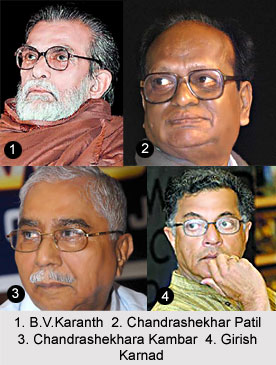 Contemporary Kannada theatre reached a phase of change during 1950s. Until then theatre was going downhill, thanks to the popularity of Indian cinema. People started to lose interest and charm. While on one hand, Company Nataka, had fully exhausted itself and the movement for amateur stage did not achieve its professionalism that could actually help to make an impact outside the limited circles. Furthermore, while opposing the Company mode for its excesses of theatricality, the experiments with amateur theatre itself remained a deprived theatre of speech. As a result, in order to keep the art alive, an immediate assimilation was needed urgently. This dire-strait was first identified by Sriranga. He not only wrote about it also did his best to find ways out of the problem. Thereafter, in late 1950s, under the banner of Natya Sangha, Sriranga organized a series of theatre workshops, the first of their kind in the Indian state of Karnataka. This step actually facilitated in informal training for amateurs and also resulted in new interest among the theatre lovers.
Contemporary Kannada theatre reached a phase of change during 1950s. Until then theatre was going downhill, thanks to the popularity of Indian cinema. People started to lose interest and charm. While on one hand, Company Nataka, had fully exhausted itself and the movement for amateur stage did not achieve its professionalism that could actually help to make an impact outside the limited circles. Furthermore, while opposing the Company mode for its excesses of theatricality, the experiments with amateur theatre itself remained a deprived theatre of speech. As a result, in order to keep the art alive, an immediate assimilation was needed urgently. This dire-strait was first identified by Sriranga. He not only wrote about it also did his best to find ways out of the problem. Thereafter, in late 1950s, under the banner of Natya Sangha, Sriranga organized a series of theatre workshops, the first of their kind in the Indian state of Karnataka. This step actually facilitated in informal training for amateurs and also resulted in new interest among the theatre lovers.
Till 1960s Kannada Theatre had not developed any identity of its own. There were actors of great calibre here and there, but they alone failed to bring about the much needed change. At this very juncture, the arrival of Babukodi Venkataramana Karanth (B. V. Karanth) did wonders to Kannada theatre as a whole. In the later part of 1960s, there was a noticeable change in the way Kannada theatre was perceived and projected. B. V. Karanth took Kannada theatre to nook and corner of the state, working with children and theatre troupes. This period was significant for the fate of contemporary Kannada theatre as, Sriranga, through his dramatic skills, had already attracted the notice of the educated class. And with the arrival of B.V.Karanth from the National School of Drama Kannada, theatre obtained a much needed vigour and impetus. Karanth was a trained gentleman. He made the theatre more flexible but brought to it a new sophistication as well. This euphoria, which was generated around B.V.Karanth, inspired many new and young people to take up theatre. As a result actors like G. V. Shivananda and C. R. Simha, technicians like V. Ramamurthy, as well as active groups such as Benaka and Rangasampada in Bengaluru, Samatento in Mysore, Ninasam in Heggodu took theatre as their career. They eventually intensified the momentum of the amateur movement.
During 1950s the effect of Navya (new or modernist movement) developed in Kannada literature was also felt in drama. Playwrights like Sriranga and Joshi, who were older, changed their style from realism to selections of post-realistic approaches, leading to a series of new works and trends in the 1960s. Some names during that period are Chandrashekhar Patil, N. Rama, and Chandrakantha Kusnoor. Three other significant playwrights also surfaced during that period like P. Lankesh, Girish Karnad, and Chandrasekhar Kambar. Together, they consolidated the Kannada theatre.
With time, lot of theatre troupes from amateur stage started significant and active performances in Mangalore, Udupi, Dharwad, Davangere, and smaller places like Sullia, Ilkal, Manchikeri, and Heggodu
Girish Karnad`s `Tughalaq` (1964), one of the most creative personalities, is a product of contemporary Kannada theatre. He is proficient in both Indian and Western form of drama. He imbibed a lot from theatre personalities of West Bengal like Badal Sircar, Ajitesh Bandhopadhyay. Rabindranath as a dramatist also inspired and motivated him greatly. "Sankranthi" (P.Lankesh) is the most significant Kannada play in the post Tughlaq period that dealt with social issues based on historical settings.
Chandrashekhara Kambar is another popular playwright in Kannada language. He has a rich background of the folk tradition. Though Kambar uses folk material he attempts to interpret them in the modern context. The All India Radio also played a pivotal role in making Kannada theatre popular.
The contemporary Kannada Theatre speaks volumes about the potential of the state of Karnataka. The Kannada literature, comprising of prose, poetry and novels have always been appreciated by reader and literary lovers for its rich value, but theatre somehow has always been made to play second fiddle. With the new and talented theatre personalities of Karnataka taking up the responsibly of theatre promotion, Kannada theatre, certainly looks in good stead for future.




